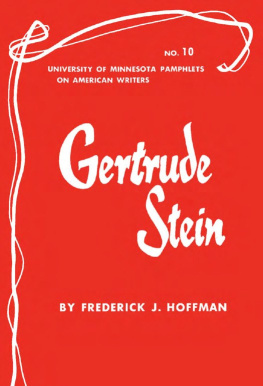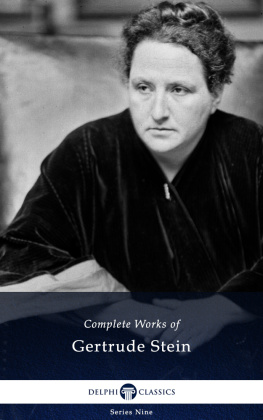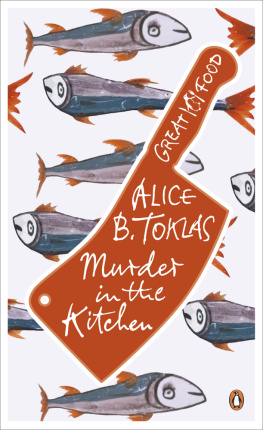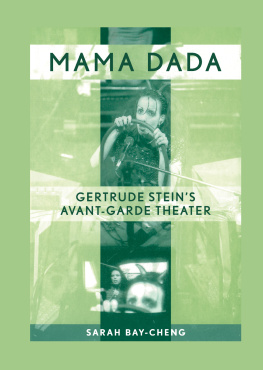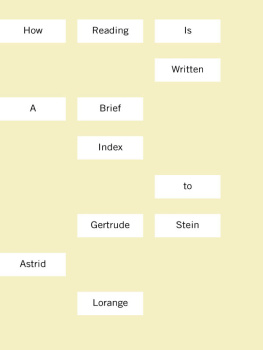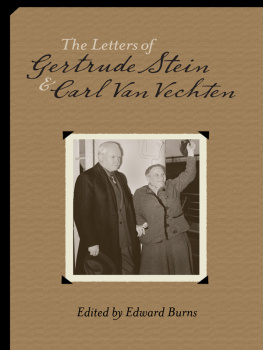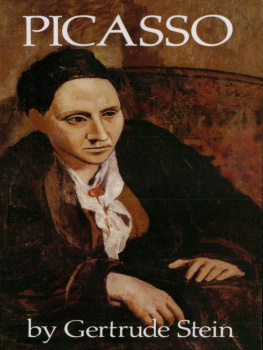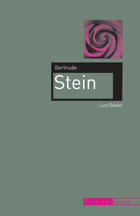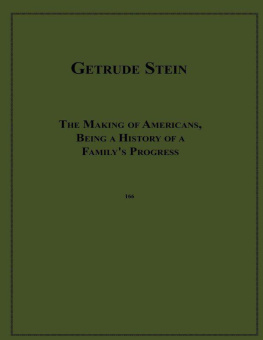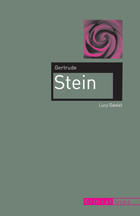Frederick J. Hoffman - Gertrude Stein (Pamphlets on American Writers)
Here you can read online Frederick J. Hoffman - Gertrude Stein (Pamphlets on American Writers) full text of the book (entire story) in english for free. Download pdf and epub, get meaning, cover and reviews about this ebook. year: 1961, publisher: Univ Of Minnesota Press, genre: Art. Description of the work, (preface) as well as reviews are available. Best literature library LitArk.com created for fans of good reading and offers a wide selection of genres:
Romance novel
Science fiction
Adventure
Detective
Science
History
Home and family
Prose
Art
Politics
Computer
Non-fiction
Religion
Business
Children
Humor
Choose a favorite category and find really read worthwhile books. Enjoy immersion in the world of imagination, feel the emotions of the characters or learn something new for yourself, make an fascinating discovery.
- Book:Gertrude Stein (Pamphlets on American Writers)
- Author:
- Publisher:Univ Of Minnesota Press
- Genre:
- Year:1961
- Rating:4 / 5
- Favourites:Add to favourites
- Your mark:
- 80
- 1
- 2
- 3
- 4
- 5
Gertrude Stein (Pamphlets on American Writers): summary, description and annotation
We offer to read an annotation, description, summary or preface (depends on what the author of the book "Gertrude Stein (Pamphlets on American Writers)" wrote himself). If you haven't found the necessary information about the book — write in the comments, we will try to find it.
Gertrude Stein (Pamphlets on American Writers) — read online for free the complete book (whole text) full work
Below is the text of the book, divided by pages. System saving the place of the last page read, allows you to conveniently read the book "Gertrude Stein (Pamphlets on American Writers)" online for free, without having to search again every time where you left off. Put a bookmark, and you can go to the page where you finished reading at any time.
Font size:
Interval:
Bookmark:
FREDERICK J. HOFFMAN, who taught at the Universityof Wisconsin, Milwaukee, was the author, co-author,or editor of a number of books. Among them areFreudianism and the Literary Mind, The ModernNovel in America, and The Twenties.
ALL RIGHTS RESERVED
Lund Press, Inc., Minneapolis
AT LEAST three Gertrude Steins have been accounted for inmodern criticism, biography, and gossip: the formidably graciousand effective matron of modern American letters, expatriate mistressof ceremonies; the theorist of language and literature and oftheir fusion in composition as explanation of the thing seen; andthe artist, author of two or three distinguished books and of a dozenor more provocative and puzzling others. The first of these hasbeen abundantly described, testified to, and in one sense or anotherexploited. From the time she agreed to separate from brother Leo(1912), to set up her own literary shop in Paris, her prestige as aninformal arbiter of special tastes in the arts grew and flourished. Sheposed for the role, and having succeeded in carrying it off, becameconvinced of its genuineness and worth. Subsequently the roles ofhostess and critic were combined, and in her triumphant tour ofAmerica (1934-35) she was known both as an engaging and intriguingpersonality and as a person who had many penetratingthings to say. At times vague, often apparently naive, she was neverthelessappreciated by those who knew her and troubled themselvesto read her work as a dedicated spirit, narrowly intent uponexpanding and illustrating her original views of language and itsliterary function.
The woman who invited gossip, superficial interest in her eccentricities,laughter and even ridicule, was a part of the ceremony thatwas her work. That she was received with enthusiasm in the 1920sby many of the postwar generation of writers is a testimony to thefascination she exercised over young talents looking for new formsand manners. When she settled in Paris (1903), at 27, rue deFleurus, she was unknown and unpublished. With her brother shebegan to purchase modern paintings (Picasso, Matisse, Cezanne,Braque) and to encourage the careers of several artists. Her talentfor judging the art may have been debatable, but her skill in makingthe artist indebted to her was not; and in a few years her salon featureda variety of paintings, vying for the honor of a position onits walls. They were dominated by Picassos portrait of her, whichlooked down upon its subject at her desk, a memorable testimonyto the beginnings of twentieth-century experiment in the arts.
The response to Miss Stein was not always respectful. The verynature of her insistence upon divergent forms and practices puzzledmany and made them shy away from what seemed to them aclever game or a play for notoriety. As a dominating woman, sheinspired trust in many at the start, then offended that trust orseemed to exploit it too selfishly. The flowers of friendship oftenfaded. The sponsors of realistic decorum, who wanted their literatureintelligible and overtly purposeful, left her early; onlyThree Lives (1909) pleased them, and this not all. But even moretolerant contemporaries found her work wearisomely repetitious,formless, and offensively coy. While she seemed in the vanguard ofthe new literature and was for a time (in the 1920s especially) honoredby its pundits and sponsors, her position as titular head of theavant-garde was often threatened and finally lost altogether. Harshridicule of her stubborn dowagership was not uncommon; andhowever simply honest and decorous her mnage aux arts provedactually to be, the spectacle of the mistress of ceremonies invitedsuspicion both of her motives and of the clarity of her intentions.Katherine Anne Porter, who on at least one other occasion hadfound her work formidably impressive, provided the most cleverlydevastating of disparagements (in an essay, The Wooden Umbrella,1947). She described Miss Stein as of the company ofAmazons which nineteenth-century America produced among itsmany prodigies: not-men, not-women, answerable to no functionin either sex, whose careers were carried on, and how successfully,in whatever field they chose: they were educators, writers, editors,politicians, artists, world travelers, and international hostesses, wholived in public and by the public and played out their self-assumed,self-created roles in such masterly freedom as only a few earlymedieval queens had equaled.
Miss Porters suggestion of the female prodigy is not altogetherunwise, though she does not appreciate sufficiently the facts of hersubjects persistence and of her dedication to an art and the theoryof an art. Gertrude Stein did not begin her career as a writer; when,after she had reached the age of fifteen and begun to understandboredom (as John Malcolm Brinnin puts it, in The Third Rose,1959), she thought of the life of a scholar. At Radcliffe, which sheentered in 1893, she had courses with George Santayana, JosiahRoyce, William Vaughn Moody, and, most important, WilliamJames. Her first interest was experimental psychology, and withLeon Solomons she collaborated on a study of Normal MotorAdjustment (Psychological Review, September 1896). She thenbegan a course in pre-medicine at the Johns Hopkins University,thinking that it would be the best preparation for the life of apsychologist.
The academic life did not last. In 1902, she and Leo traveled toEngland, where she sat for a while in the British Museum, livingcontinuously, as Brinnin says, with the English language. In thenext year, Leo found the Paris apartment where she was to live mostof her life to the beginning of World War II. The years as a student,the time spent reading English classics, and the experiences ofbuying and defending contemporary art all fell quite neatly intothe pattern that was her life and her career. She was very much theAmerican artist; but, like many Americans of a later generation,she found Paris an ideal second country from which to observeand to describe her native land.
It almost seemed that Miss Steins first years in Paris were intendedas a way of preparing for modern literature. In The Autobiographyof Alice B. Toklas (1933) she served as a historian ofthe new generation (or at least, an informal diarist of its affairs),but she was also actively engaged in sponsoring and directing itsambitions. Before World War I she was interested mostly inpainting and, very much with Leos help, learned to understandmodernist painting and bought and displayed the new canvases;above all, she considered Cezanne and Picasso as closely identifiedwith what she was trying to do in writing. When the youngergeneration of writers arrived from America (or stayed on, afterthe war), many of them headed for the rue de Fleurus and theauthor of Three Lives and Tender Buttons (1914). In the 1920s,she became the leader of an informal salon, in which she talkedwith and advised Hemingway, Fitzgerald, Sherwood Anderson,and scores of others, known and unknown, talented and mediocre.She shared this role of elder spokesman with another pioneerexpatriate, Ezra Pound (who was in Paris in the early 1920s),and with Ford Madox Ford, a British poet and novelist who editedthe Transatlantic Review in 1924-25.
Her career as sponsor of bright young men was not without itsdifficulties, many of them of her own making; but despite personalsquabbles, her reputation as an informal critic grew and shewas soon asked to explain her methods on more formal occasions.The most famous of these were the trip in 1925 to Oxford andCambridge universities, where she delivered the lecture Compositionas Explanation, which remains the key discussion of herliterary practice; and the months spent in America a decade later.From the latter excursion came
Next pageFont size:
Interval:
Bookmark:
Similar books «Gertrude Stein (Pamphlets on American Writers)»
Look at similar books to Gertrude Stein (Pamphlets on American Writers). We have selected literature similar in name and meaning in the hope of providing readers with more options to find new, interesting, not yet read works.
Discussion, reviews of the book Gertrude Stein (Pamphlets on American Writers) and just readers' own opinions. Leave your comments, write what you think about the work, its meaning or the main characters. Specify what exactly you liked and what you didn't like, and why you think so.

